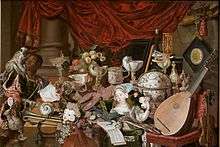The Paston Treasure

The Paston Treasure is a large oil on canvas painting and historically rare record of a cabinet of treasures in British collecting. Commissioned by Sir Robert Paston in the early 1670s it depicts some of the Paston family's collected treasures. The painting was executed by an unknown Dutch artist who sojourned at the Paston family residence at Oxnead Hall near Aylsham in Norfolk in order to complete the commission.[1]
The objects were collected by Robert and his father, Sir William Paston (c.1610–1663) who made acquisitions on a long journey travelling through Europe and on to Cairo and Jerusalem. The collection consisted of over 200 objects and included many natural curiosities made into decorative art objects, such as mounted seashells and ostrich eggs. The Paston Treasure was acquired by Norwich Castle Museum in 1947 where it, along with the strombus shell in an enamelled mount, is currently on display as part of the Norwich Castle Museum Collection.
The importance of The Paston Treasure lies in the international scope and interest of the objects portrayed, reflecting both exotic nature and the skills of man. It is to be the subject of an exhibition in 2018 in which Norwich Castle Museum in partnership with the Yale Centre for British Art in the USA, are planning to reunite as many of the objects depicted for the first time in 350 years.[2]
The Paston Treasure is the subject of a forthcoming book by senior research scientist, conservator and art-historian, Spike Bucklow.[3]
References
- ↑ Previously attributed to either Franciscus Gijsbrechts or Pieter Gerritsz van Roestraten a Dutch painter active in England from 1666.
- ↑ "The Paston Treasure, Microcosm of the Known World / East Anglia Art Fund". Eastangliaartfund.org.uk. Retrieved 2017-02-28.
- ↑ "Spike Bucklow, U. of Cambridge, "John Donne's Melancholic Portrait"". Events.stanford.edu. Retrieved 2017-02-28.